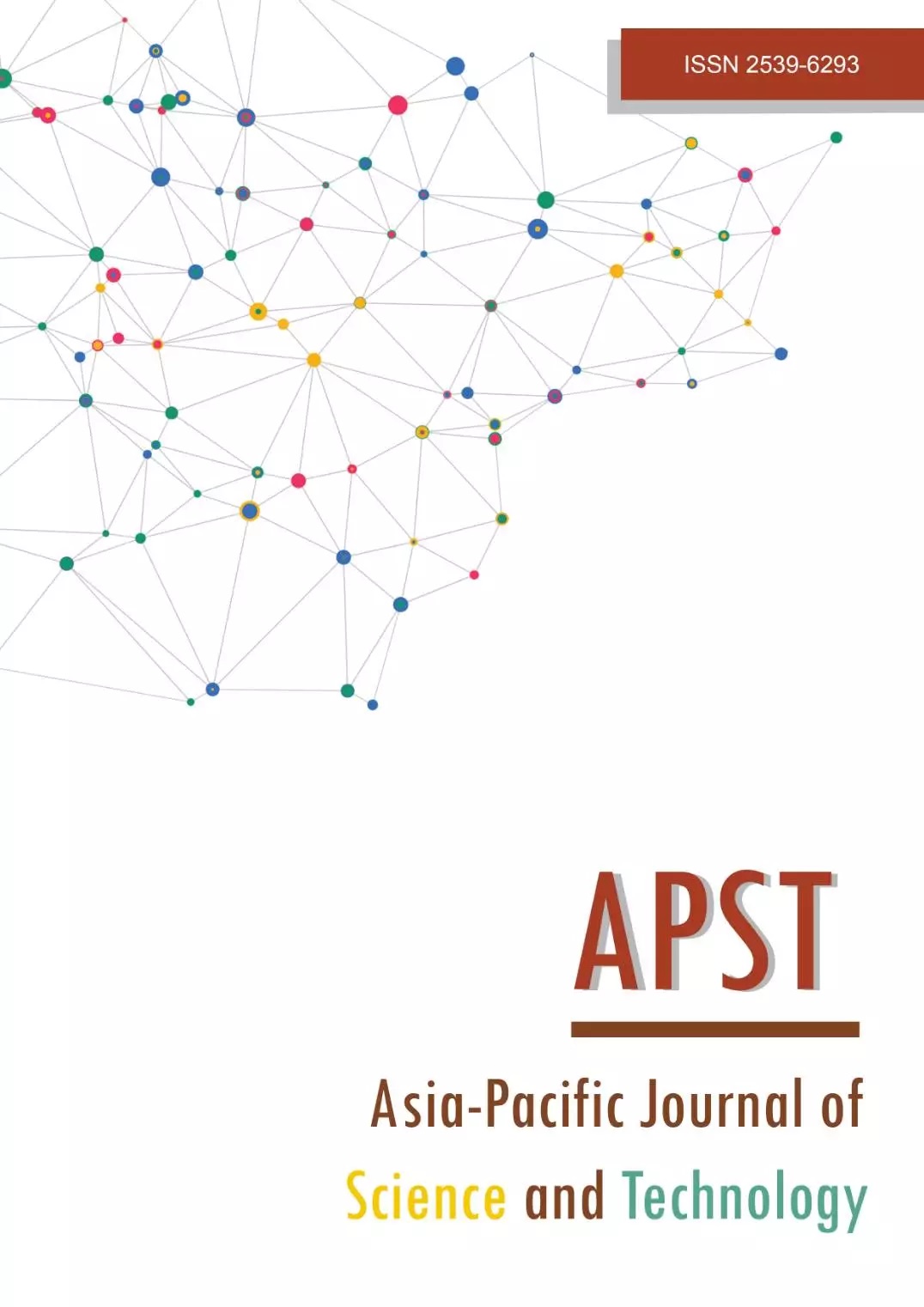Digital whole slide imaging for pleural fluid cytopathology diagnosis: Accuracy, sensitivity, specificity, and concordance
Main Article Content
Abstract
Digital whole slide imaging (WSI) is a developing technique enabling digital pathology for research applications. This investigation aimed to determine the accuracy, sensitivity, specificity, and concordance of non-gynecological cytopathology specimen (pleural fluid) diagnoses made using WSI and glass slides. Sixty pleural fluid cytology specimens were prepared in glass slides and scanned with a digital slide scanner for WSI. Two pathologists interpreted both the glass and digital slides then the accuracy, sensitivity, specificity, and concordance (Kappa coefficient) of their diagnoses were examined between the techniques. A three-week interval separated the WSI and glass slide interpretations. The results found by pathologists 1 and 2 showed that the WSI accuracy were 91% and 93%, sensitivity was 89.3% and 86.7%, specificity was 92.3% and 100%, and concordance (Kappa coefficients) were 87% (0.74, p <0.001) and 95% (0.90, p< 0.001), respectively. Therefore, WSI has the potential to be applied in the diagnosis of pleural fluid cytology with accuracy, sensitivity, specificity, and concordances equal to standard diagnosis techniques. In the future, the flexibility, and utility, and other potential aspects of WSI will be widely used in research and routine cytopathological diagnosis.
Article Details

This work is licensed under a Creative Commons Attribution-NonCommercial-NoDerivatives 4.0 International License.
References
Cunningham CM, Larzelere ED, Arar I. Conventional microscopy vs. computer imagery in chiropractic education. J Chiropr Educ. 2008;22(2):138-144.
Weinstein RS, Graham, AR, Richter LC, Barker GP, Krupinski EA, Lopez AM, et al. Overview of telepathology, virtual microscopy, and whole slide imaging: prospects for the future. Hum Pathol. 2009; 40(8):1057-1069.
Higgins C. Applications and challenges of digital pathology and whole slide imaging. Biotech Histochem. 2015;90(5):341-347.
Hanna MG, Monaco SE, Cuda J, Xing J, Ahmed I, Pantanowitz L. Comparison of glass slides and various digital-slide modalities for cytopathology screening and interpretation. Cancer Cytopathol. 2017; 125(9):701-709.
Wright AM, Smith D, Dhurandhar B, Fairley T, Scheiber PM, Chakraborty S, et al. Digital slide imaging in cervicovaginal cytology: a pilot study. Arch Pathol Lab Med. 2013;137(5):618-624.
Chantziantoniou N, Mukherjee M, Donnelly AD, Pantanowitz L, Austin RM. Digital applications in cytopathology: problems, rationalizations, and alternative approaches. Acta Cytol. 2018;62(1):68-76.
Nishat R, Ramachandra S, Behura SS, Kumar H. Digital cytopathology. J Oral Maxillofac Pathol. 2017; 21(1):99-106.
Steinberg DM, Ali SZ. Application of virtual microscopy in clinical cytopathology. Diagn Cytopathol. 2001;25(6):389-396.
Pavlides M, Birks J, Fryer E, Delaney D, Sarania N, Banerjee R, et al. Interobserver variability in histologic evaluation of liver fibrosis using categorical and quantitative scores. Am J Clin Pathol. 2017; 147(4):364-369.
Marchevsky AM, WanY, Thomas P, Krishnan L, Evans SH, Haber H. Virtual microscopy as a tool for proficiency testing in cytopathology: a model using multiple digital images of papanicolaou tests. Arch Pathol Lab Med. 2003;127(10):1320-1324.
Van SL, Kumar RK, Pryor WM, Salisbury EL, Velan GM. Cytopathology whole slide images and adaptive tutorials for senior medical students: a randomized crossover trial. Diagn Pathol. 2016;11(1):1-9.
Pantanowitz L, Sinard JH, Henricks WH, Fatheree LA, Carter AB, Contis L, et al. Validating whole slide imaging for diagnostic purposes in pathology: guideline from the college of American pathologists pathology and laboratory quality center. Arch Pathol Lab Med. 2013;137(12):1710-1722.
Mukhopadhyay S, Feldma MD, Abels E, Ashfaq R, Beltaifa S, Cacciabeve NG, et al. Whole slide imaging versus microscopy for primary diagnosis in surgical pathology: a multicenter blinded randomized noninferiority study of 1992 cases (pivotal study). Am J Surg Pathol. 2018;42(1):39-52.
Hanna MG, Reuter VE, Hameed MR, Tan LK, Chiang S, Sigel C, et al. Whole slide imaging equivalency and efficiency study: experience at a large academic center. Mod Pathol. 2019; 32(7):916-928.
Wilbur DC, Madi K, Colvin RB, Duncan LM, Faquin WC, Ferry JA, et al. Whole-slide imaging digital pathology as a platform for teleconsultation: a pilot study using paired subspecialist correlations. Arch Pathol Lab Med. 2009;133(12):1949-1953.
Girolami I, Pantanowitz L, Marletta S, Brunelli M, Mescoli C, Parisi A, et al. Diagnostic concordance between whole slide imaging and conventional light microscopy in cytopathology: a systematic review. Cancer Cytopathol. 2020;128(1):17-28.
Saco A, Bombi JA, Garcian A, Ramirez J, Ordi J. Current status of whole-slide imaging in education. Pathobiology. 2016;83(2-3):79-88.
Kumar N, Gupta R, Gupta S. Whole slide imaging (WSI) in pathology: current perspectives and future directions. J Digit Imaging. 2020;33(4):1034-1040.
Farris AB, Cohen C, Rogers TE, Smith GH. Whole slide imaging for analytical anatomic pathology and telepathology: practical applications today, promises, and perils. Arch Pathol Lab Med. 2017; 141(4):542-550.
Bashshur RL, Krupinski EA, Weinstein RS, Dunn MR, Bashshur N. The empirical foundations of telepathology: evidence of feasibility and intermediate effects. Telemed J E Health. 2017;23(3):155-191.
Alami H, Fortin JP, Gagnon MP, Pollender H, Tetu B, Tanguay F. The Challenges of a complex and innovative telehealth project: a qualitative evaluation of the Eastern Quebec telepathology network. Int J Health Policy Manag. 2018;7(5):421-432.
Khalbuss WE, Cuda J, Cucoranu IC. Screening and dotting virtual slides: a new challenge for cytotechnologists. Cytojournal. 2013;10(1):22.
Shen J, Zhang JP, Jiang B, Chen J, Song J, Liu Z, et al. Artificial intelligence versus clinicians in disease diagnosis: systematic review. JMIR Med Inform. 2019;7(3):e10010.
Bi WL, Hosny A, Schabath MB, Giger ML, Birkbak NJ, Mehrtash A, et al. Artificial intelligence in cancer imaging: clinical challenges and applications. CA Cancer J Clin. 2019;69(2):127-157.
Wang S, Yang DM, Rong R, Zhan X, Fujimoto J, Liu H, et al. Artificial intelligence in lung cancer pathology image analysis. Cancers (Basel). 2019;11(11):1673.
Park SH, Han K. Methodologic guide for evaluating clinical performance and effect of artificial intelligence technology for medical diagnosis and prediction. Radiology. 2018;286(3):800-809.
Bera K, Schalper KA, Rimm DL, Velcheti V, Madabhushi A. Artificial intelligence in digital pathology - new tools for diagnosis and precision oncology. Nat Rev Clin Oncol. 2019;16(11):703-715.


